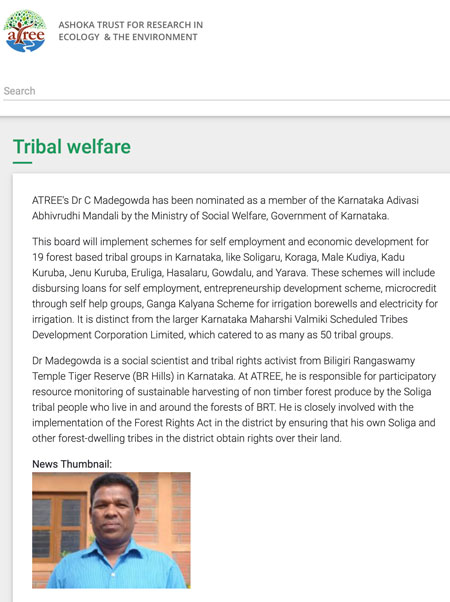The Uttara Kannada district is home to many indigenous tribal communities among others, including the Sidhis, Goulis, Kunabis, Gondas and the Halakki.
The Halakki people are scattered across several Taluks of Uttara Kannada district namely Karwar, Ankola, Kumta, Gokarna and Honnavar. | Learn more >>
Tulasi Gowda, a 72-year-old tribal woman from Karnataka, was conferred the Padma Shri award on Monday [8 November 2021] for her contribution to the protection of the environment. […]
Barefoot and dressed in traditional attire, she received India’s fourth-highest civilian award from President Ram Nath Kovind during a ceremony in New Delhi.
Belonging to the Halakki indigenous tribe in Karnataka, Tulasi Gowda grew up in a poor and disadvantaged family. She never received a formal education, and yet, today she is known as the ‘Encyclopedia of the Forest’. This is because of her vast knowledge of diverse species of plants and herbs.
Since the age of 12, she has planted and nurtured thousands of trees. Tulasi Gowda also joined the forest department as a temporary volunteer, where she was recognised for her dedication to nature preservation. She was later offered a permanent job in the department.
Today, even at the age of 72, Tulasi Gowda continues to nurture plants and share her vast knowledge with the younger generation to promote the importance of environmental conservation.
Source: “Meet Padma Shri Tulasi Gowda, the barefoot environmentalist known as ‘Encyclopedia of Forest'”, India Today Web Desk, 8 November 2021
URL: https://www.indiatoday.in/india/story/padma-shri-tulasi-gowda-barefoot-environmentalist-encyclopedia-of-forest-1874499-2021-11-08
Date Visited: 9 November 2021
[Bold typeface added above for emphasis]

Learn more about Adivasi rights in Karnataka: Participatory resource monitoring, implementation of the Forest Rights Act and welfare schemes | Research on related issues undertaken by Azim Premji University (Bengaluru) >>
“The practice of religious rituals, ceremonies and sanctions by specific cultural groups allow such sacred landscapes to be maintained, emphasizing that humans are intrinsically part of the ecosystem. Taboos, codes and customs specific to activities and community members restrict access to most sacred groves. […] The inclusion of local people’s needs and interests in conservation planning is increasingly accepted as essential, both to promote the well-being of human populations, and to ensure that biodiversity and conservation needs are met in the long-term.” – Nazir A. Pala, Ajeet K. Neg and N.P. Todaria in “The Religious, Social and Cultural Significance of Forest Landscapes in Uttarakhand Himalaya, India” (International Journal of Conservation Science, Vol. 5, Issue 2, April-June 2014) | Sacred groves | Biodiversity and development – Himalaya >>
“Even though they are responsible for protecting the largest part of the global forest heritage […] a third of indigenous and community lands in 64 countries are under threat due to the lack of land tenure rights.” – Pressenza Rio de Janerio in “Indigenous people are heading to CoP26: ‘There is no solution to the climate crisis, without us‘” (Down To Earth) | Forest dwellers in early India – myths and ecology in historical perspective by Romila Thapar >>
Up-to-date reports by Indian journalists and commentators
List of Indian magazines and web portals covered by the present Custom search engine
To search Indian periodicals, magazines, web portals and other sources safely, click here. To find an Indian PhD thesis on a particular tribal community, region and related issues, click here >>
Search tips
Combine the name of any particular state, language or region with that of any tribal (Adivasi) community.
Add keywords of special interest (health, nutrition endangered language, illegal mining, sacred grove); learn about the rights of Scheduled Tribes such as the “Forest Rights Act” (FRA); and the United Nations “Declaration on the Rights of Indigenous Peoples”, “Universal Declaration of Human Rights”, “women’s rights”, or “children’s right to education”.
Specify any other issue or news item you want to learn more about (biodiversity, bonded labour and human trafficking, climate change, ecology, economic development, ethnobotany, ethnomedicine, global warming, Himalayan tribe, hunter-gatherers in a particular region or state, prevention of rural poverty, water access).
For official figures include “scheduled tribe ST” along with a union state or region: e.g. “Chhattisgarh ST community”, “Scheduled tribe Tamil Nadu census”, “ST Kerala census”, “Particularly Vulnerable Tribal Group Jharkhand”, “PVTG Rajasthan”, “Adivasi ST Kerala”, “Adibasi ST West Bengal” etc.
In case the Google Custom Search window is not displayed here try the following: (1) toggle between “Reader” and regular viewing; (2) in your browser’s Security settings select “Enable JavaScript” | More tips >>
See also
Adverse inclusion | Casteism | Rural poverty
Demographic Status of Scheduled Tribe Population of India (Census figures 2011)
Fact checking | Figures, census and other statistics
Human Rights Commission (posts) | www.nhrc.nic.in (Government of India)
Search tips | Names of tribal communities, regions and states of India
“What is the Forest Rights Act about?” – Campaign for Survival and Dignity
“Who are Scheduled Tribes?” – Government of India (National Commission for Scheduled Tribes, NCST)